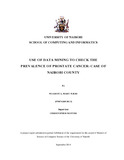| dc.contributor.author | Ngaruiya, Mary N | |
| dc.date.accessioned | 2014-12-04T09:52:20Z | |
| dc.date.available | 2014-12-04T09:52:20Z | |
| dc.date.issued | 2014 | |
| dc.identifier.uri | http://hdl.handle.net/11295/76376 | |
| dc.description.abstract | Prostate cancer has been on the rise in the past years and alarming cases being found in men in
their 20’s. The problem is that most of the cases are diagnosed in their late stages thus the
mortality rate being high. In recent years data driven analytic studies have become a common
complement with new and novel research where different tools and algorithms are taking a centre
stage in cancer research. In this research, the main goal is to use datamining to derive patterns
which will be used in building a prognostic tool that helps in identification of the Gleason score
once screened and advice on the treatment technique. In this research, we used two popular data
mining tools (R Environment and WEKA) which exhibited almost same results .The dataset
contained around 485 records and 7 variables. In WEKA, a 10-fold cross-validation was used in
model building in comparing ANN and J48. The results showed that ANN is the most accurate
predictor compared to J48 in all the instances. This study contributes to society, academics and
cancer research which ultimately assist in reduction of mortality rates by use of pattern
recognitions which leads in better decision making. | en_US |
| dc.language.iso | en | en_US |
| dc.publisher | University of Nairobi | en_US |
| dc.subject | Artificial Neural Network, Data Mining, GIS, prostate cancer, J48 (decision trees), R, WEKA | en_US |
| dc.title | Use of data mining to check the prevalence of prostate cancer: case of Nairobi county | en_US |
| dc.type | Thesis | en_US |
| dc.type.material | en_US | en_US |

